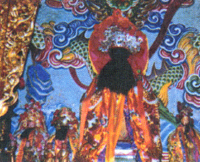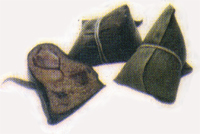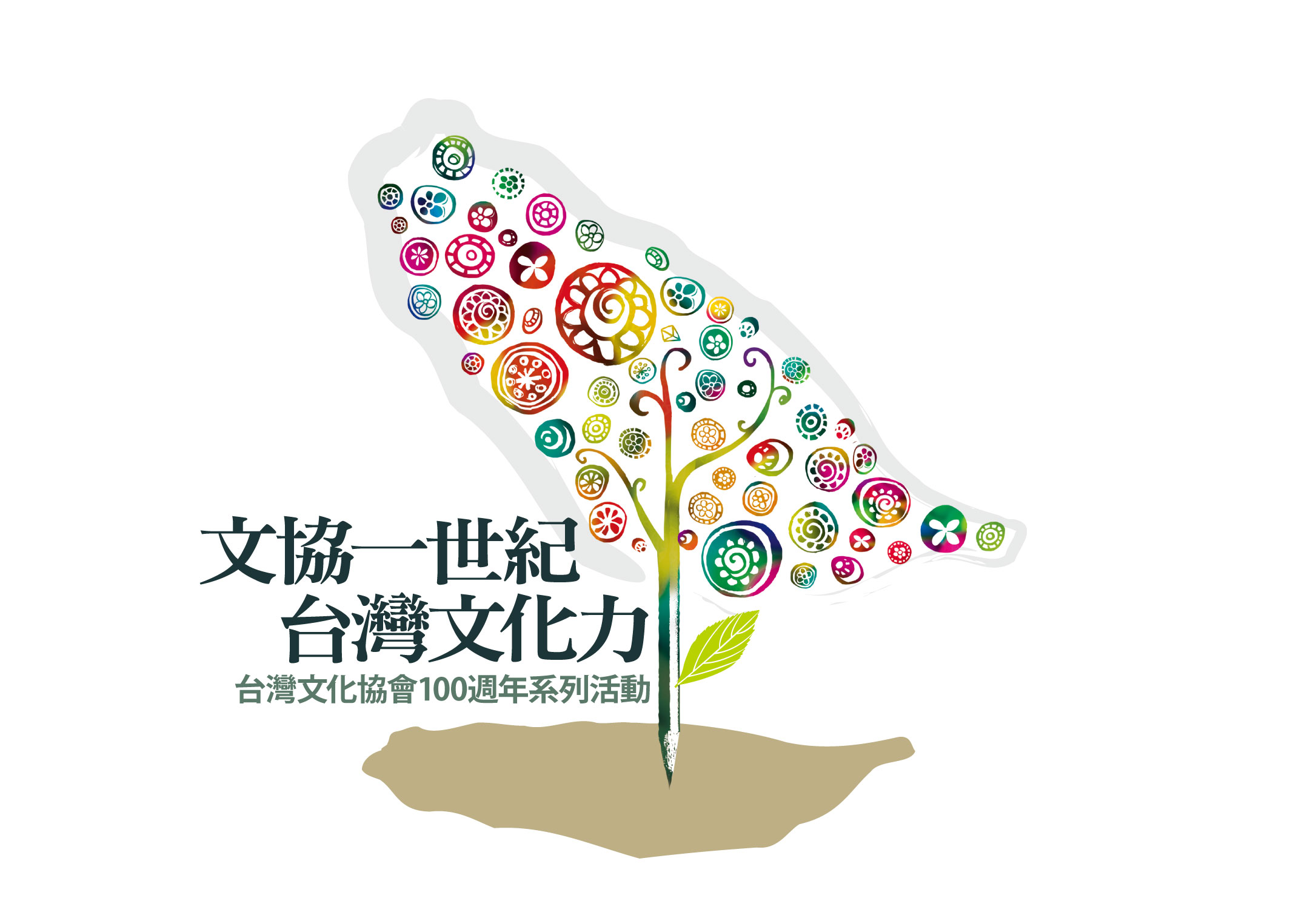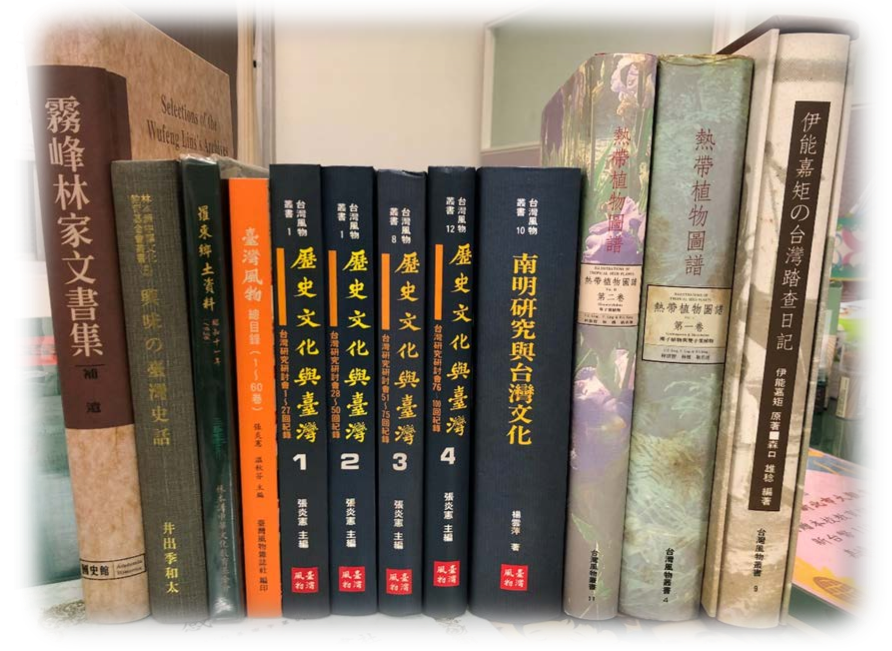 五月五日端午節
五月五日端午節
Dragon Boat Festival
戴寶村/Tai Pao-Tsun
(中央大學歷史系教授)
(Professor, History Department, National Central University)
2001-06-25
農曆五月五日的端午節與「清明節」、「中秋節」並列為台灣三大節慶,每年政府與民間皆舉辦相關民俗活動與製作應景食品將這個節日點綴地十分熱鬧。然而雖然有許多人吃粽子、觀賞龍舟賽,但大部分人對於端午節的歷史今昔,除了戰國時代屈原投江的故事以外,卻都一知半解。因此本週台灣歷史之窗特別邀請中央大學歷史系副教授戴寶村執筆,細說端午節流傳的幾個典故與相關的民俗慶典活動。
The Dragon Boat Festival on the fifth day of the fifth month in Taiwan’s lunar calendar, the Tomb Sweeping Festival and the Mid-Autumn Festival are Taiwan’s three biggest festivals. Every year, the government and ordinary people alike hold folk activities and eat special festival foods to make these days special and lively. However, although many people will eat zongzi and watch dragon boat racing, most of us know little about the historical background of this festival apart from the story of Qu Yuan throwing himself into the river back in the Warring States period. That’s why Taiwan News has this week invited Tai Pao-tsun, professor from the history department at National Central University, to write about our weekly feature, Window on Taiwan, on the historical allusions connected with the Dragon Boat Festival, and the related folk festivities and activities .

屈原宮裡的水仙尊王The Narcissus King in the Qu Yuan Temple
端午節由來的幾個傳說
台灣農曆五月五日稱作「五日節」或「端午節」,這段時間正值春夏節氣交替之際,民間以五月為毒月,為了驅邪避毒保健平安而產生一些民間風俗。五月節的由來有數種傳說,一是源自紀念中國古代投水自殺的楚國詩人屈原,用竹葉包紮米飯為粽子投入水中祭拜他而來;一是為紀念中國東漢時代的孝女曹娥,因他父親溺江而亡,曹娥沿江號哭尋覓父屍達十七日而不得,遂投江自殺,五天之後適為五月五日,父女相擁的屍體浮出水面,民眾感念其孝行而祭之;一為中國春秋時代的吳國名臣伍子胥幫助吳國攻打越國大勝,他主戰以滅越國,吳王不聽反命他自殺,屍體在五月五日被投入江中,後人乃在這天紀念伍子胥。這些傳說還是以屈原的故事流傳比較廣,台北市士林區的洲美裡就有一座屈原宮主祀屈原,端午節前後前往祭拜的信徒相當多。總之五日節與江河有密切關係,划龍舟比賽成為最重要的水上活動,包粽子是應節的食物,還有一些驅邪求福的行事,這一天也是詩人節,傳統詩人會再在這天集會吟詩慶祝,是台灣一年當中相當熱鬧的節日。
Some legends about the origins of the Dragon Boat Festival
The fifth day of the fifth month of Taiwan’s lunar calendar is the “Festival of the Fifth” or “Dragon Boat Festival.” This period is the time when spring weather is replaced by that of summer, and the fifth month is often called “poison month,” and several folk customs have arisen to drive out evil spirits, keep poison at bay and stay healthy and safe. There are numerous stories about the origin of the Fifth Month Festival. One says that it commemorates Qu Yuan, the poet from the state of Chu who committed suicide by drowning in ancient China, and people offer sacrifices to him by plunging zongzi made of rice wrapped in bamboo leaves into water; another says that it commemorates the filial daughter, Cao E, from the Eastern Han dynasty. Because her father had drowned in a river, Cao E walked along the river’s edge for 17 days, crying her eyes out and looking for her father’s body, but she never found it, and so she threw herself into the river and drowned herself. After five days, on the fifth day of the fifth month, the bodies of father and daughter came to the surface, intertwined, and people were so moved by her filial behavior that they memorialized her by making sacrifices to her. Yet another story tells that in the Spring and Autumn period in China [722 to 481 B.C.], in the state of Wu, the famous courtier, Wu Zixu, helped the state of Wu to attack and win a great victory over the state of Yue. He advocated war to destroy Yue, but the king of Wu did not heed him, but instead ordered him to commit suicide, and on the fifth day of the fifth month, his body was thrown into the river. Later on, people commemorated Wu Zixu on this day. Among these legends, the story of Qu Yuan is he most widely known. In the Chou Mei ward of Shihlin District, Taipei City, there is a temple dedicated to Qu Yuan, and around the Dragon Boat Festival, many devotees come to the temple to offer sacrifices to Qu Yuan. In conclusion, the festival of the Fifth Day is closely tied up with rivers, and dragon boat races have become the most important water-related activity, while zongzi is the food of choice for the festival, and there are also some luck-seeking behaviors and activities to ward away evil spirits. This day is also a festival for poets, and traditionally, poets gather together on this day to recite poems and celebrate. It’s a very vibrant and busy festival in Taiwan’s calendar.

虎形香包
Tiger-shaped fragrant sachet
端午節的民俗活動
五月五日為了驅邪避毒,因此會在家中門口懸掛菖蒲、艾草、榕樹枝,希望驅逐邪魔使身體健康。喝雄黃酒也可避邪,或將雄黃撒在房子四周以驅蟲。父母會製作香包內裝香料,讓兒童懸掛可保佑子女平安成長,還有讓兒童玩豎雞蛋的遊戲。另外又有傳說在五月五日中午中午十二點所取的「午時水」可以久放不變味,還可以治百病的說法,其中以大甲鐵砧山上的「劍井」的午時水最有名。鐵砧山劍井的傳說源自鄭成功領軍北上行軍此地,缺水可供部隊飲用,於是鄭成功拔劍插入地下,並祝禱祈求湧出泉水,果然地下泉水噴湧,解除軍隊渴旱的危機,所以現在鐵砧上有劍井,而且湧泉不絕,據說當天也正是端午節,所以附近民眾會在五日節中五前往求取午時水,也是中部地區特別有趣的民俗活動。
Folk activities of the Dragon Boat Festival
On the fifth day of the fifth month, in order to ward off evil spirits, people hang branches of moxa, calamus and banyan around the doors of their homes, in the hope that this will drive away evil spirits and keep everyone healthy. Drinking realgar wine can also drive away the evil spirits, as can sprinkling realgar in all four corners of the house to get rid of insects. Parents may make scented sachets stuffed with fragrant material and hang these around their children’s necks to protect their children and bless them with a safe passage into adulthood, and also organize games where children must try to balance an egg on its end. It’s also said that water drawn at 12 noon on the fifth day of the fifth month will stay fresh for longer than usual, and can also be used to treat many illnesses. Water drawn at noon from the “Sword Well” at Tie Chen Hill (“Anvil Hill”), Tachia (Taichung County) is the most famous. The story of the Sword Well at Tie Chen Shan says that when Koxinga was leading his army north, they ran out of water here, and Koxinga pulled out his sword and plunged it into the ground, and prayed for water to spring forth. And of course he hit an underground source of water which gushed out, and rescued his troops from the danger of dehydration. That’s why the Sword Well is there on Tie Chen Hill, and the water has never dried up. Legend has it that that day was the day of the Dragon Boat Festival, so the local people go there to draw water at noon on the fifth day of the fifth month, and it’s one of the particularly interesting folk activities of central Taiwan.
 粽子
粽子
Zongzi
粽子的演變與象徵意涵
端午節應時的食品是粽子,其由來是說屈原自殺以後,有人遇到屈原的亡魂,亡魂說:他雖然投江而亡,但魂魄未死,人們投到江中的食物,大多被魚類所吃,希望往後將米飯裝在竹桶中,投到江中他就可以吃得到,後來再演變為用竹葉包粽子,丟入水中祭拜屈原,這就是粽子的由來。台灣的粽子大致分為鹼粽和鹹粽兩種口味,又有台灣式、廣東式、江浙式等各種形式的不同,代表台灣食物豐富多元的特色。同時這段時間也接近各級學校畢業升學考試之際,包粽子也有考試「包中」(上榜)之意,不只是食物還有祈求考試成功的象徵涵意。
The evolution and symbolic meaning of zongzi
The seasonal food for the Dragon Boat Festival is zongzi, the origins of which are to be found with Qu Yuan. After his suicide, somebody ran into his ghost, which said that although he had drowned in the river, his soul did not die, and the food people threw into the river was mostly eaten by the fish, and he would like people to put rice in bamboo tubs from now on, so that he could eat it. Later on, the custom changed and the food became zongzi wrapped up in bamboo leaves, which were tossed into the water as offerings to Qu Yuan. Zongzi in Taiwan can be divided into two flavors: salty and alkaline. There are many different regional styles, such as Taiwanese, Guangdong and Zhejiang, which show the rich variety of food to be found in Taiwan. This time of year is also close to graduations and entrance exams for all levels of schools, and the expression “bao zongzi” (wrapping up zongzi) can have the meaning of “bao zhong” which means to pass one’s exams, so the zongzi is not just food but also has a symbolic meaning of praying for examination success.
 天中戲水(宮廷中的龍舟競賽)/宋 李嵩
天中戲水(宮廷中的龍舟競賽)/宋 李嵩
Playing in the heavenly waters (dragon boat racing at the imperial court)/ Song Dynasty, Li Song
端午節的水上活動--划龍舟
端午節的重頭戲是「划龍舟」,其傳說也是與屈原有關,據說屈原自殺以後人們划船找屈原時,曾看見有龍在江上飛騰,所以日後的搜索船的船頭就做成龍頭,船尾就做成龍尾,船身畫上龍麟,成為所謂的龍舟。其實這些都是傳言附會之說,划船比賽是華南到東南亞地區,各個民族流行的水上活動。端午節這天台灣各地從宜蘭、基隆、台北、鹿港、台南、高雄等各地都會舉行盛大的劃龍舟比賽,也是一年一度重要的水上活動比賽;台灣是一個海島國家,划船比賽的確是一值得大力推廣的活動。
Activities on the water for the Dragon Boat Festival: dragon boat racing
The most important activity of the Dragon Boat Festival is the dragon boat racing. According to legend, this too is connected with the story of Qu Yuan. It’s said that after Qu Yuan killed himself, people paddled boats looking for him, and saw a dragon flying over the river. From that time on, dragon heads were carved onto the prows of search boats, and dragon tails at the other end, with dragon’s scales painted along the length of the boat, so that they became what were called “dragon boats.” Actually these are all myths, and the dragon boat races were a traditional folk waterways activity in Southern China and Southeast Asia. On the day of the Dragon Boat Festival, grand dragon boat races will be held all over Taiwan, in Ilan, Keelung, Taipei, Lukang, Tainan and Kaohsiung, a major annual water activity. Taiwan is an island nation, and the dragon boat races are certainly activities well worth promoting.
台北市的龍舟競賽規模盛大,淡水河上游的新店隊和下游關渡地區的隊伍勢均力敵,長期對抗互有勝負,台北龍舟賽現在更發展為國際性的比賽,龍舟競賽過去都是在淡水河舉行,經常配合演藝活動或進行電視實況轉播,增添節慶的氣氛。台北縣萬里鄉甚至在海上舉行划龍舟比賽,競賽過程緊張精彩。宜蘭縣焦溪鄉二龍村的龍舟賽則是因其特殊的傳統形式而受到重視,甚至被交通部觀光局指定為重點觀光活動。
Taipei City holds dragon boat races on a grand scale, and the Hsintien team from upstream on the Tamshui river is well-matched with the team from downstream Kuantu. They compete for a long time, and both have victories and defeats. The Taipei dragon boat racing has now developed into an international competition. In the past, all the races were held on the Tamshui river, and there are often performance activities or live TV broadcasts being carried out at the same time, adding to the festival atmosphere. At Wanli Township in Taipei County, dragon boat races are even held in the sea, on a nerve-wracking and wonderful course. The dragon boat races at Er Lung Village, in Chiaohsi Township, Ilan County, are famous for their special traditions, and are even noted by the Tourism Bureau as a tourist attraction.
二龍村的龍舟賽一向只有兩隊參加,分別是上二龍村的淇武蘭隊和下二龍村的洲子尾隊,淇武蘭的龍舟是以綠色為底色,洲子尾的龍舟是以紅色為底色,兩隊在二龍溪反覆進行數十次比賽,村民輪番上陣值到黃昏時刻,最後在以兩隊勝負的次數多寡決定輸贏。這風俗據說是源起自平埔族原住民噶瑪蘭人祭祀河川的禮俗,後來漢人大量進入宜蘭開墾後,逐漸轉變為划船競賽。
The dragon boat races at Er Lung Village have always been held between two teams only, the Chiwulan team from upper Er Lung, and the Choutzuwei team from lower Er Lung. The Chiwulan dragon boat has a green background, and the Choutzuwei dragon boat has a red background. The two teams race up and down the Er Lung river dozens of times, and the villagers take it in turns to participate until the early evening, and the winner is finally calculated from the number of victories and defeats by both teams. This custom is said to come from the river-worshipping ceremony of the Kavalan people, who are one of the Aboriginal Pingpu tribes, and when Han Chinese began to develop and exploit the land of Ilan in large numbers, this ceremony gradually turned into a dragon boat race.
驅逐病疫的活動--消逝的石戰風俗
端午節適逢春夏交替,過去台灣傳染病盛行,所以有舉行驅逐病疫祈求健康的儀式,民間還有流傳在端午節扔擲石塊互鬥,藉著激烈運動流汗排熱而免除疾病的行為。依據約七十年前日本人的調查,今屏東縣佳冬、林邊、新埤、枋寮鄉村地區民眾,在農曆五月五日時,組成對抗團體,在田野或草地互扔擲石塊戰鬥,男子負責丟擲石頭,女子負責收集石塊以供戰鬥,雙方將石塊丟擲對方,但不近身搏鬥,投石越多越好,只要敵方退卻就算勝利,勝者可以取用敗方的食物佳餚,敗方若被俘遭羞辱或處罰也不可以反抗。據說有一次瘧疾流行,村民參與石戰,激烈運動流汗排熱,竟然使傳染病得以痊癒,於是石戰風氣更為盛行。不過偶爾還是會發生人員受傷,或是破壞他人房屋、財物之事情,日本人將其視為影響治安的陋習加以取締,或是藉著舉辦運動會轉移競爭行為,這種石戰的風俗從此逐漸消失。
Activities to ward off sickness: the vanished custom of rock battles
The Dragon Boat Festival marks the end of spring and the beginning of summer, and in the past, Taiwan was rife with infectious diseases, and so ceremonies would be carried out to ward off sickness and pray for health. There still exist folk customs where during the Dragon Boat Festival, people would fight each other by throwing rocks, and thanks to the vigorous exercise, the participants would sweat heavily and thus avoid disease. This was recorded by the Japanese about 70 years ago: people in the area which is now the Pingtung villages of Chiatung, Linpien, Shinpi and Fangliao would group together on the fifth day of the fifth month and go out into the fields or the meadows, and fight by throwing stones at one another. The men’s job was to throw the stones, and the women’s job was to collect stones for the fights. Each side threw stones at the other, but they didn’t come into physical contact, and the more stones they threw, the better, and the side which held out the longest was the winner, and was allowed to eat delicious dishes prepared by the losing side. If the losing side was taken captive and humiliated, or punished, they were not allowed to resist. It is said that one time, malaria was going around, and when the villagers participated in the rock fight, their sweating from the vigorous exercise rid their bodies of fever, and they actually made a full recovery from this infectious disease, upon which the practice of rock battles became even more prevalent. However, it would occasionally happen that someone got hurt, or damaged another’s house or property, and the Japanese saw this as an undesirable activity which had a detrimental effect on public order, and enforced a ban on it. Or it may be that the sport had a habit of turning into fights. Anyway, these rock fights gradually began to die out during the Japanese Occupation.
照片提供:國立故宮博物院、雄獅圖書股份有限公司
Compiled and edited by Tina Lee/Translated by James Decker
編輯李美儀/英文翻譯曹篤明









